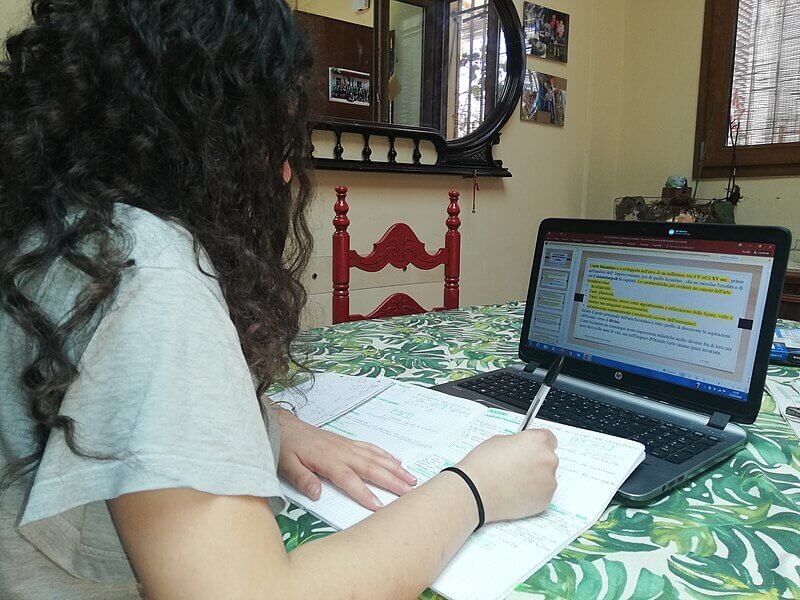Although they are sometimes used synonymously, it is important to know the differences between online, virtual, distance, and remote emergency education. Know their differences and characteristics.
The overall uncertainty in the world today is forcing us to make radical changes in many sectors of our lives. One of them is education, which plunged overnight into a state of global emergency. Different delivery methods have been used to respond to the crisis; these are referred to as online, virtual, distance, and emergency-remote, to name a few. Are there differences among them? I discovered that virtual education and online education are two different teaching modalities. Still, we could easily believe they are synonymous. I consider it beneficial to learn about their differences, discover what type of teaching our children receive, their characteristics, and their advantages.
Online education
Online education occurs when teachers and students participate and interact in a digital environment using the internet and computer networks’ technological resources synchronously; that is, their use must coincide with established session schedules. This method usually has areas of opportunity in the social dimension: The teacher may have to make extra effort to put together a class meeting with a climate of freedom and create trust among the students to achieve pedagogical goals. An example of online education is classes taught through Zoom sessions. Subsequently, the assigned activities are uploaded to Canvas or Blackboard platforms for the teacher to review.
Teacher role: Teachers who participate in online education are often referred to as “tutors” because, unlike in a physical classroom, their role within the virtual classroom is to accompany and assist students in their learning process.
Tools: Schoology, Edmodo, Blackboard, Zoom, Google Hangouts, and Google Scholar, etc.
Advantages
-
Openness: Access to information is expanded because this method overcomes geographic barriers; anyone, regardless of their location, can attend the courses.
-
Flexibility: It promotes self-management of time devoted to study and assignments.
-
Effectiveness: This method promotes the development of personal autonomy; the student self-manages.
-
Personalized accompaniment: Online education is distinguished by the personalized accompaniment to the students, even when working in teams.
-
Economy: The costs of physical spaces and transfers are reduced.
-
Community: Online education promotes debate and dialogue in a community connected through academic knowledge.
Virtual education
This model requires technological resources, such as a computer or tablet, an internet connection, and the use of a multimedia platform. Unlike online education, this method works asynchronously, i.e., the teachers’ sessions and the students’ schedules do not have to coincide. This method is similar to distance education, but strictly with technological resources. Course materials or documents are uploaded to the chosen platform for students to review. Questions are usually discussed in public forums for the entire group.
Teacher role: Delivers the course and shares work materials through platforms. Students can subsequently upload their activities for review and then receive feedback from the teacher to see their areas of opportunity to improve.
Tools: Platforms like Canvas, Blackboard, Edmodo, Schoology, or email.
Advantages
-
Flexible: Because the method can be handled asynchronously, students have more flexibility to manage their schedules and professional time as they prefer.
-
Efficient: The classes are presented session-feedback, which moves the topics quickly, avoids distractions, and carries the students at the same pace.
Distance education
Unlike virtual education, distance education can be partly face-to-face and virtual; however, this may vary depending on the educational institution. Students have control over the time, space, and pace of their learning because no internet connection or computational resources are required, as they are in other methods. The materials used are usually physical, such as notebooks, pens, crayons, memory sticks, and CDs. Many programs even send educational materials and lessons by postal mail. A current example of distance education is the Ministry of Public Education’s open television channels in Mexico at the beginning of the quarantine, in some cases supported by radio broadcasts.
Teacher role: When teachers receive the students’ completed learning resources, such as their activity assignments, USBs, or CDs, they have a responsibility to grade and credit the students and provide them feedback. This can be by phone, email, or text messages. Also, some teachers have the role of recording the sessions or classes to be broadcast on television or radio.
Tools: Television, radio, email, postal mail, physical resources such as note binders, books, notebooks, pencils, etc.
Advantages
-
Flexibility: The students manage their personal and school time and organization.
-
Accessibility: Distance education programs are broad in scope and reach people of all socioeconomic levels, thanks to the classes’ technological resources’ simplicity.
Emergency remote education
This concept was born in the wake of the global crisis in March this year, due to COVID-19. Education found itself in extreme difficulty as it had to adapt its methods to continue teaching rapidly. This type of education aims to move the courses taught in-person to a remote, virtual, distance, or online classroom. A report published by The Learning Factor in Peru entitled “Emergency Remote Teaching” described that different countries and institutions responded differently to the educational changes. The term “emergency remote education” is entirely new, as roles and tools are not defined. For example, in the United States, some educational institutions are teaching face-to-face but with restrictions imposed. Others are using the online modality described above. So, the definition depends on how the country or institution has decided to manage the crisis.
Teacher role: May vary, depending on the method used.
Tools: Vary, depending on the method used.
Advantages
-
This method prioritizes education as an emergency and looks out for the well-being of the students.
-
This new term refers to consolidating all actions from governments, businesses, non-governmental organizations, and individuals to find solutions and keep up to date constantly; education can suddenly adapt if the emergency changes.
Our world is in a stage of reconstruction where any type of learning is welcome. That is why topics like these are relevant to all people because they affect the future of today’s generations. Distance education has become very suitable. New technologies have become our right-hand resources in the process, helping us stay connected without physical interactions. Future generations will remember this new chapter, so it is doubly important to be conscious of the decisions we make now and how we will address the challenges that confront us in the future.
Translation by Daniel Wetta.
This article from Observatory of the Institute for the Future of Education may be shared under the terms of the license CC BY-NC-SA 4.0 
)
)


)